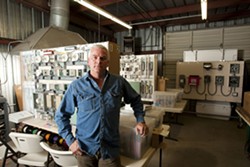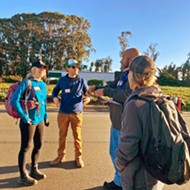State of the unions
Unions survive and thrive in the shadows of the great recession
By Robert A. Mcdonald[{
"name": "Newsletter Promo",
"id": "NewsletterPromo",
"class": "inlineCenter",
"insertPoint": "4",
"component": "15264767",
"requiredCountToDisplay": "0"
},{
"name": "Ad - Medium Rectangle CC01 - 300x250",
"id": "AdMediumRectangleCC01300x250",
"class": "inlineCenter",
"insertPoint": "8",
"component": "2963441",
"requiredCountToDisplay": "12"
},{
"name": "Ad - Medium Rectangle LC01 - 300x250",
"id": "AdMediumRectangleCC01300x250",
"class": "inlineCenter",
"insertPoint": "18",
"component": "2963441",
"requiredCountToDisplay": "22"
},{
"name": "Ad - Medium Rectangle LC09 - 300x250",
"id": "AdMediumRectangleLC09300x250",
"class": "inlineCenter",
"insertPoint": "28",
"component": "3252660",
"requiredCountToDisplay": "32"
}]
Down with unions.
Long live unions.
Those two sentiments represent just about all you hear when you turn on the TV news or pick up a newspaper. Whether it’s the battles raging over union rights in Wisconsin or local fire and police unions facing off with the chamber of commerce, it’s easy to fall into the clichés peddled by both sides of the red and blue divide.
While government unions get a lot of press, most others operate out of the public eye; they represent workers that contribute to our lives in ways that are vital to modern life but are rarely acknowledged or even recognized.
New Times decided to look into some of these unions and see what life’s like for some of their locals and the workers they serve.
The importance of cherry purple
Connie loves getting her nails done.
Her fingernails gleamed with freshly painted polish as she returned to her house on a recent warm afternoon. The nails were a deep, dark, cherry purple, which happens to be her favorite color.
Though she’s been getting her nails painted that color nearly all her life, she hasn’t seen the shade in more than 50 years.
Connie is 67, and she’s been almost totally blind since she was 18. She was trapped in a house fire in 1967 and barely survived. The flames burned more than 50 percent of her body, disfiguring her hands. Doctors didn’t expect her to live.
But live she did. She learned to walk, and even to use her hands again.
“Hello, so nice to meet you,” Connie said to a reporter after her trip to the salon.
Though blind, hard of hearing, and recovering from a fall that broke both of her legs, Connie looked great.
“She can do nearly anything,” her brother, Les Beck, said after she left to exercise. He’s one of her caretakers and a board member of the Homecare Providers Union, the UDW (Union of Domestic Workers). “I don’t know what I’d do without her.”
The real question is: What would Connie do without her brother and her other caretaker? Connie is one of thousands of disabled or aging persons who live on their own only through the help of a state program, In-Home Social Services (IHSS).
IHSS allows the elderly, the blind, and the disabled to stay in their homes instead of living in a nursing home. The government pays for a caretaker to assume responsibility for most of the patient’s needs—housecleaning, meal preparation, laundry, grocery shopping, personal care services, etc. To qualify for IHSS, you need to be in pretty rough shape: You must own less than $2,000 worth of property, not including your house.
Connie lives with her brother. A caretaker, Lynnette Osgood, minds her during the week, and Les attends to her on weekends.
Les is a retired schoolteacher and wasn’t much involved in the unions when he was working in that capacity. Things changed when he became a caretaker.
“The union goes to bat for you,” Les said. “They fight for better wages and benefits.”
Les said this as firmly as he could. He doesn’t fit any stereotype of a union leader. Mild-mannered and patient, Les looks like the kind of person you’re thankful to see over the table at a parent-teacher conference.
Caretakers don’t earn much—about $10 an hour—and have few benefits. Union workers attribute these relatively low wages to the endangered nature of California’s IHSS program; it’s been a constant target of state budget cutters. Former Governor Arnold Schwarzenegger tried to drastically cut the $5.5 billion program—the state pays $1.5 billion of that cost, the federal government and counties the rest—but was thwarted by the Democratic legislature. Gov. Jerry Brown proposed cutting $486 million from the program, which would have purged 87 percent of the patients from the rolls, leaving only the most needy. The legislature proposed lesser cuts, but the program’s future is still up in the air.
Connie would likely still be in the program, Les said, but the long-term prospects for both patients and the state’s pocketbook would be dire. The program’s patients would either wind up on the streets or likely flood nursing homes, which, in the end, would cost the taxpayer more than if they had remained in the program.
Connie was in a nursing home after she broke her legs in a fall. Her world shrunk to the size of her bed. The nurses didn’t know her or understand her needs. Sometimes they would give her the wrong meal or forget she was blind and place her food out of reach. It was a lonely place, a mere holding area for the elderly. A 101-year-old would come into her room and say there just wasn’t anyone to talk to anymore.
That’s the world Les is trying to save his sister from.
“It’s what we are fighting for,” he said.
As Les talked more about the union, it began to become clear that his enthusiasm for the organization is about more than protecting the rights of providers; it’s about protecting his sister and the program that lets her lead a life she can call her own.
Busting heads and breaking legs?
Jimmy Hoffa looked happy. His beaming face shone down on the office of Lynn Swenson—head of the Teamsters local 381, located on Bunny Avenue in downtown Santa Maria—as Swenson talked about his union.
The picture of Hoffa, the controversial Teamster leader who disappeared in 1975 and was rumored to have mob ties, was among the classic union paraphernalia festooning the wood-paneled walls of Swenson’s office. The office is nice, in a Mad Men meets The Brady Bunch kind of way.
“So how did you get your job?” this reporter asked.
“I killed the last guy here and buried him in the parking lot,” Swenson said with a cold stare.
Then, to this reporter’s great relief, his face dissolved into a warm smile. Ha! A joke! But such is the classic stereotype of the Teamsters: rough, tough, and dangerous. It’s an image Swenson discounted in the interview, but also seemed to have a good sense of humor about.
Swenson, a Teamster member since 1977, actually got his job when the last union local leader retired. He and his union colleagues are well aware of the cultural labels they’re stuck with.
He recently went to a middle school to give a talk to the young students on career day. He preached to them about how Teamsters can be blue-collar workers, yet make good wages and benefits and even get a pension—a rarity in the work world the children would one day join. Swenson thought he’d done an excellent job extolling the strength of unions when a boy raised his hand and asked, “Are the Teamsters still involved with the mob, and are they still burying people in unmarked graves?”
Aside from any image problems they may have, the Teamsters are doing well—both at the local and national level, Swenson said. The record bears that out: In the last few decades, Teamsters have been unionizing the employees of United Parcel Services and several other large companies.
The local covers Northern Santa Barbara County and all of San Luis Obispo County and handles around 50 contracts that cover 1,400 members. The Teamsters represent many different professions, but transportation is the tenuous link that binds all the groups together. The union began by originally representing horse team drivers in the 19th century.
Though the union can’t boast a full-time organizer, Swenson and two other union officials are charged with bringing in new union members. Usually, the workers come to him.
“They’ve heard something about the Teamsters, and they want to organize and for us to help them,” Swenson said. “We’re monthly contacted by someone who wants to organize.”
Sometimes the caller speaks for only a few of the workers, making it impossible to mobilize an entire organization, but sometimes it turns out they speak for a majority.
Swenson will then try to get the employees to form a core committee committed to unionizing. Then Swenson and his comrades try to visit the home of every employee to talk about what the Teamsters can—or can’t—do for them.
The employees are given cards to fill out to indicate whether they’re interested in unionizing. The national labor relations board requires 30 percent to trigger a vote, but Swenson said he prefers to have closer to 70 or 80 percent, because after the company begins its counter-union campaign, the numbers will whittle down.
Then comes the vote. If 50 percent of the workers plus one agree to it, the workforce will be unionized.
Few employers are pleased to see Teamsters arriving on their doorstep.
“If they’re happy with their pay and their benefits and how they’re getting treated, then they don’t need me,” Swenson said. “I’m often contacted by people who used to be happy with their jobs, and now, because of bad economic times or the desire for more profit, now all of the things are getting cut back. … People want to protect what they have.”
Strikes have faded from the scene for the Teamsters; the last local strike was nearly 10 years ago.
“For employers, it’s just not worthwhile,” Swenson said. “the days back when we used to see a lot of strikes, companies had a lot of money and unions were not asking for anything unreasonable, so a strike would break the deadlock. Companies now realize unions are asking for reasonable wage increase benefits and [contract] language improvements. No one really wins in a strike.”
Owners realize a strike can devastate a company, Swenson said, and the money workers lose by going on strike can be more than they would win in the end.
Workers are more interested in job security in these desperate times, and negotiations often center on the seemingly smaller details in the contract language, i.e. work rules that can shape every aspect of the workplace.
When asked what he wants people to know about the Teamsters, Swenson smiled and said this: “You should tell them we’re loving, kind, and compassionate people looking to do the best for union members in every aspect of their life.”
As he said this, a reporter pointed out a license plate frame on the wall that said, “Busting heads and breaking legs.”
“Oh, that. That’s just a gift from my daughter. It’s a joke. It’s a long story,” Swenson said with a giggle.
“Are we still mean and tough? Yes, we just don’t like to talk about it, especially not to reporters,” Swenson added with a laugh.
Electric boogie woogie
A few miles south of the SLO city limits on Edna Road sits a long, gray, hangar-like building. It doesn’t look like much, but it’s the headquarters of the local 639 of International Brotherhood of Electrical Workers (IBEW). Step inside, and you’ll find yourself in an earlier time. Old electrical equipment lines the wall of the receptionist hallway, and a large meeting room looks like a perfect venue for a Cub Scout den meeting. Classrooms full of desks and electrical equipment take up most of the space.
The building is a home base for a trade union, which is a union that represents a single craft. Sometimes such unions cater to a specific skill set. In the case of the 639, it’s electrical construction, a category that still covers a lot of ground. The union’s biggest “customer” is the Diablo Canyon Power Plant, mostly during reactor fueling.
The center of the union’s work consists mainly of two lists or books. Book one is for local electricians, and book two is for out-of-towners.
When electricians want to work, they call to put themselves on one of the lists. Then they call in at night to learn what jobs are available. If they hear of a job they want, they have to come to the union hall at 8:30 a.m.
The longer an electrician is on the list, the closer he or she gets to the top, which amounts to dibs on an incoming job.
Mark Satterfield, the union’s recording secretary and organizer, said he recruits both electricians and companies to the union.
“I am always on the lookout for electricians in the industry,” he said. “Being a member gives a lot of long-term benefits, which is why they want to join.”
Union members get health care and a pension when they retire.
“Our pensions aren’t anything like government pensions,” Satterfield said. “We fully fund our pensions.”
Journeyman electricians—the top skill grade in the union—get $33.70 an hour. It takes six years of training and experience to be a journeyman.
Rick Burke, an apprentice electrician, is in the process of joining the union.
“It’s better opportunity for me and my family to work union,” Burke said. “I want to work for the best companies and get a chance to look forward to something when you get older.”
Companies come to the union for stability and quality workers.
“When [contractors] get the big jobs, they know they will get quality workers,” Satterfield said. “Nobody does the training we do, and we provide the flexibility of having that quality always available.”
Satterfield sometimes sounds more like a salesman than a union organizer when he talks about the quality of his workers.
“That’s the only way we can compete in the world today,” he said. “We used to have everything sewed up before, but not anymore. Now we need to compete and be more productive and knowledgeable in the trade.”
Contact Staff Writer Robert A. McDonald at [email protected].
Latest in News
Readers also liked…
-

Coast Unified teachers upset over new position's salary and qualifications
Oct 20, 2022 -

SLO police identify alleged driver who hit and killed couple
Dec 22, 2022 -

When the levee breaks: Oceano residents, county officials walk a tightrope of regulations to manage Arroyo Grande Creek, which some say led to the levee's failure in January
May 18, 2023










